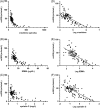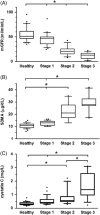Comparison of the diagnostic value of symmetric dimethylarginine, cystatin C, and creatinine for detection of decreased glomerular filtration rate in dogs
- PMID: 30791142
- PMCID: PMC6430914
- DOI: 10.1111/jvim.15445
Comparison of the diagnostic value of symmetric dimethylarginine, cystatin C, and creatinine for detection of decreased glomerular filtration rate in dogs
Abstract
Background: Early detection of decreased glomerular filtration rate (GFR) in dogs is challenging. Current methods are insensitive and new biomarkers are required.
Objective: To compare overall diagnostic performance of serum symmetric dimethylarginine (SDMA) and serum cystatin C to serum creatinine, for detection of decreased GFR in clinically stable dogs, with or without chronic kidney disease (CKD).
Animals: Ninety-seven client-owned dogs: 67 dogs with a diagnosis or suspicion of CKD and 30 healthy dogs were prospectively included.
Methods: Prospective diagnostic accuracy study. All dogs underwent physical examination, systemic arterial blood pressure measurement, urinalysis, hematology and blood biochemistry analysis, cardiac and urinary ultrasound examinations, and scintigraphy for estimation of glomerular filtration rate (mGFR). Frozen serum was used for batch analysis of SDMA and cystatin C.
Results: The area under the curve of creatinine, SDMA, and cystatin C for detection of an mGFR <30.8 mL/min/L was 0.98 (95% confidence interval [CI], 0.93-1.0), 0.96 (95% CI, 0.91-0.99), and 0.87 (95% CI, 0.79-0.93), respectively. The sensitivity of both creatinine and SDMA at their prespecified cutoffs (115 μmol/L [1.3 mg/dL] and 14 μg/dL) for detection of an abnormal mGFR was 90%. The specificity was 90% for creatinine and 87% for SDMA. When adjusting the cutoff for cystatin C to correspond to a diagnostic sensitivity of 90% (0.49 mg/L), specificity was lower (72%) than that of creatinine and SDMA.
Conclusions and clinical importance: Overall diagnostic performance of creatinine and SDMA for detection of decreased mGFR was similar. Overall diagnostic performance of cystatin C was inferior to both creatinine and SDMA.
Keywords: CKD; azotemia; biomarker; canine; renal.
© 2019 The Authors. Journal of Veterinary Internal Medicine published by Wiley Periodicals, Inc. on behalf of the American College of Veterinary Internal Medicine.
Conflict of interest statement
Harriet Syme and Jonathan Elliott have acted as consultants for, and Jonathan Elliott is in receipt of research funding from, IDEXX Ltd.
Figures





Similar articles
-
Relationship between serum iohexol clearance, serum SDMA concentration, and serum creatinine concentration in non-azotemic dogs.J Vet Intern Med. 2020 Jan;34(1):186-194. doi: 10.1111/jvim.15659. Epub 2019 Nov 14. J Vet Intern Med. 2020. PMID: 31725186 Free PMC article.
-
Symmetric Dimethylarginine Assay Validation, Stability, and Evaluation as a Marker for the Early Detection of Chronic Kidney Disease in Dogs.J Vet Intern Med. 2015 Jul-Aug;29(4):1036-44. doi: 10.1111/jvim.12835. Epub 2015 Jun 16. J Vet Intern Med. 2015. PMID: 26079532 Free PMC article.
-
Biomarkers for chronic kidney disease in dogs: a comparison study.J Vet Med Sci. 2020 Aug 28;82(8):1130-1137. doi: 10.1292/jvms.20-0125. Epub 2020 Jul 23. J Vet Med Sci. 2020. PMID: 32581150 Free PMC article.
-
Symmetric Dimethylarginine: Improving the Diagnosis and Staging of Chronic Kidney Disease in Small Animals.Vet Clin North Am Small Anim Pract. 2016 Nov;46(6):941-60. doi: 10.1016/j.cvsm.2016.06.010. Epub 2016 Aug 5. Vet Clin North Am Small Anim Pract. 2016. PMID: 27499007 Review.
-
Symmetrical Dimethylarginine: Evaluating Chronic Kidney Disease in the Era of Multiple Kidney Biomarkers.Vet Clin North Am Small Anim Pract. 2022 May;52(3):609-629. doi: 10.1016/j.cvsm.2022.01.003. Epub 2022 Apr 1. Vet Clin North Am Small Anim Pract. 2022. PMID: 35379500 Review.
Cited by
-
Serum cystatin C concentration can be used to evaluate glomerular filtration rate in small dogs.J Vet Med Sci. 2021 Jan 5;82(12):1828-1834. doi: 10.1292/jvms.20-0201. Epub 2020 Nov 10. J Vet Med Sci. 2021. PMID: 33177264 Free PMC article.
-
Serum symmetric dimethylarginine in older dogs: Reference interval and comparison of a gold standard method with the ELISA.J Vet Intern Med. 2024 Mar-Apr;38(2):960-970. doi: 10.1111/jvim.16981. Epub 2024 Jan 19. J Vet Intern Med. 2024. PMID: 38240346 Free PMC article.
-
A pilot study investigating renal biomarkers in dogs with pulmonary hypertension: a comparison between cystatin-C, symmetric dimethylarginine, and creatinine.J Vet Med Sci. 2025 Aug 1;87(8):868-875. doi: 10.1292/jvms.25-0034. Epub 2025 Jun 13. J Vet Med Sci. 2025. PMID: 40518282 Free PMC article.
-
Evaluation of Serum and Urine Neutrophil Gelatinase-associated Lipocalin and Cystatin C as Biomarkers of Acute Kidney Injury in Horses.J Vet Res. 2021 May 16;65(2):245-252. doi: 10.2478/jvetres-2021-0025. eCollection 2021 Jun. J Vet Res. 2021. PMID: 34250311 Free PMC article.
-
A Review of Specific Biomarkers of Chronic Renal Injury and Their Potential Application in Nonclinical Safety Assessment Studies.Toxicol Pathol. 2021 Jul;49(5):996-1023. doi: 10.1177/0192623320985045. Epub 2021 Feb 12. Toxicol Pathol. 2021. PMID: 33576319 Free PMC article. Review.
References
-
- Pressler BM. Clinical approach to advanced renal function testing in dogs and cats. Vet Clin North Am Small Anim Pract. 2013;43:1193‐1208. - PubMed
-
- Jacob F, Polzin DJ, Osborne CA, et al. Clinical evaluation of dietary modification for treatment of spontaneous chronic renal failure in dogs. J Am Vet Med Assoc. 2002;220:1163‐1170. - PubMed
-
- Kakimoto Y, Akazawa S. Isolation and identification of N‐G,N‐G‐ and N‐G,N'‐G‐dimethyl‐arginine, N‐epsilon‐mono‐, di‐, and trimethyllysine, and glucosylgalactosyl‐ and galactosyl‐delta‐hydroxylysine from human urine. J Biol Chem. 1970;245:5751‐5758. - PubMed
Publication types
MeSH terms
Substances
Grants and funding
LinkOut - more resources
Full Text Sources
Medical

